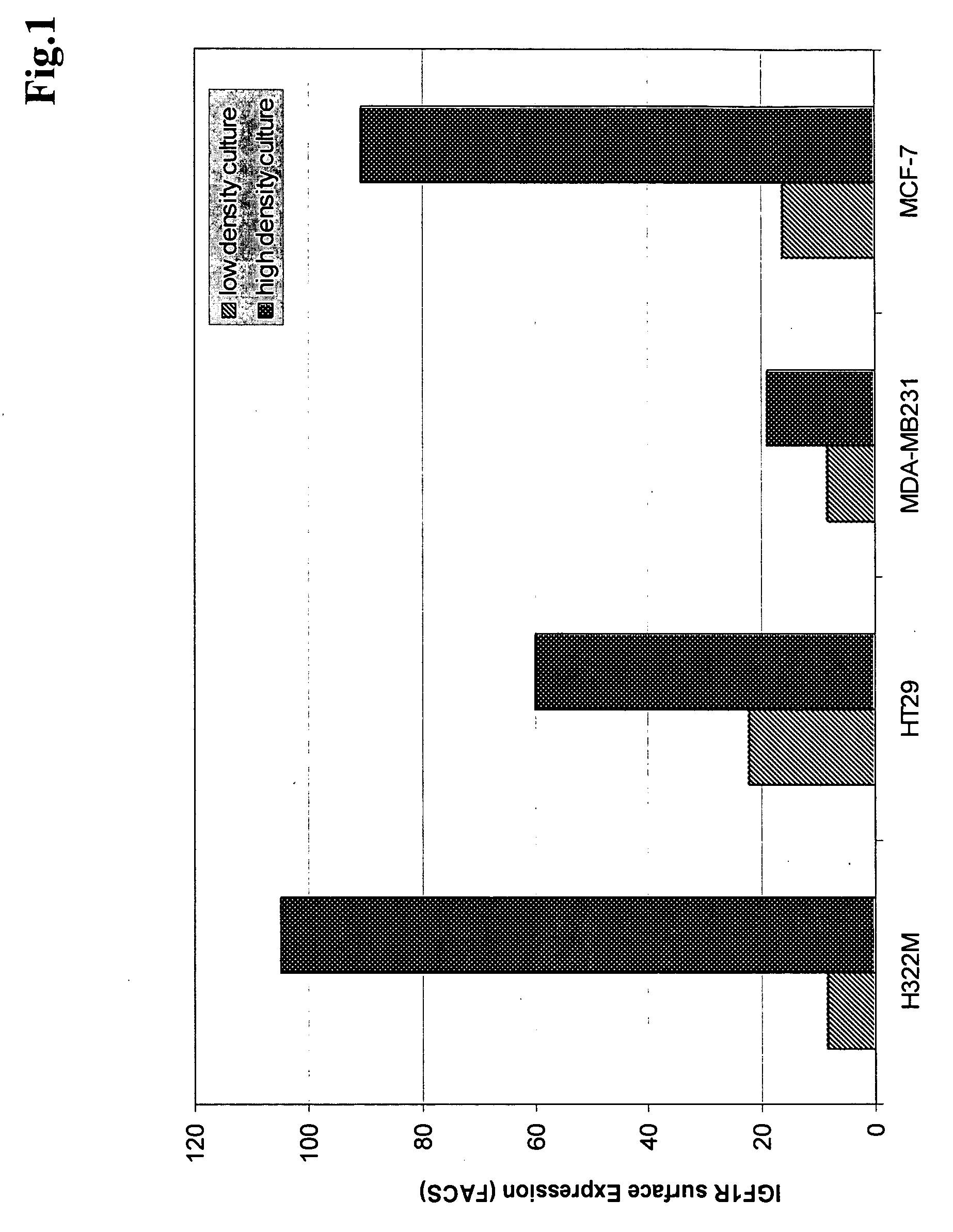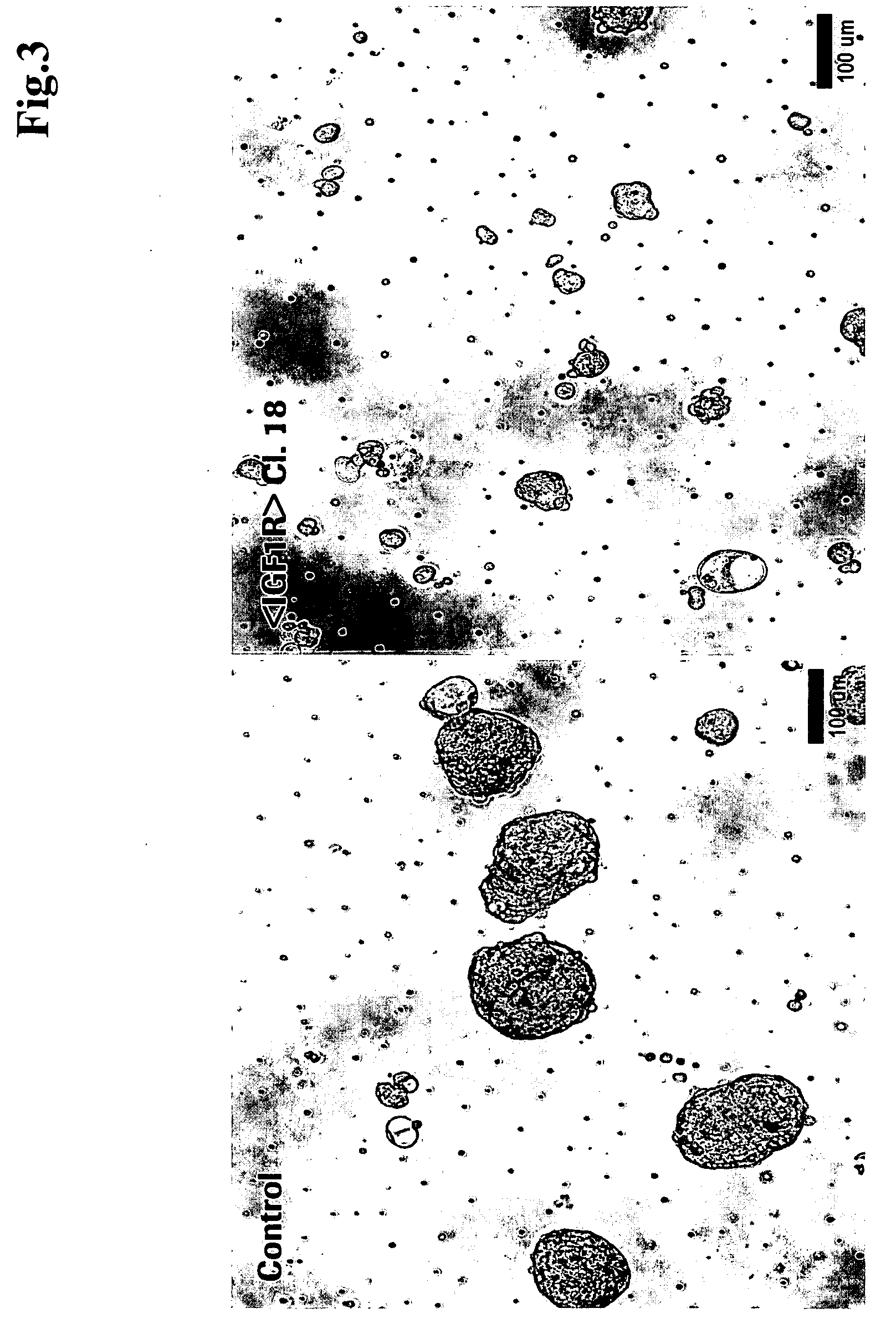Antibodies against insulin-like growth factor 1 receptor and uses thereof
an antibody and growth factor technology, applied in the field of antibodies against insulinlike growth factor 1 receptors, can solve the problems of not being shown to benefit patients in need of antitumor therapy, antibodies are not useful for human patients without, etc., and achieve the effect of prolonging the time of tumor progression and reducing tumor growth
- Summary
- Abstract
- Description
- Claims
- Application Information
AI Technical Summary
Benefits of technology
Problems solved by technology
Method used
Image
Examples
example 1
Generation of a Hybridoma Cell Line Producing Anti-IGF-IR Antibodies
[0141] Culture of Hybridomas
[0142] Generated HuMAb hybridomas were cultured in Hybridoma Express Medium (PAA Laboratories GmbH, Austria) supplemented with 2 mM L-glutamine (BioWhittaker) and 4% Origen Cloning Factor (Igen, France) at 37° C. and 5% CO2.
[0143] Immunization Procedure of Transgenic Mice
[0144] Ten HCo7 transgenic mice (4 males and 6 females), strain GG2201 (Medarex, San José, Calif., USA) were alternatingly immunized with 1×106 NIH 3T3 cells, transfected with an expression vector for IGF-IR, and 20 μg soluble extracellular domain of IGF-IR. Six immunizations were performed in total, three intraperitoneal (IP) immunizations with the IGF-IR expressing cells and three subcutaneous (SC) immunizations at the tail base with the recombinant protein. For the first immunization, 100 μl of 1×106 NIH 3T3 IGF-IR cells was mixed with 100 μl complete Freunds' adjuvant (CFA; Difco Laboratories, Detroit, USA). For a...
example 2
Determination of the Affinity of Anti-IGF-IR Antibodies to IGF-IR
[0155][0155] Instrument: BIACORE® 3000 [0156] Chip: CM5 [0157] Coupling: amine coupling [0158] Buffer: HBS (HEPES, NaCi), pH 7.4, 25° C.
[0159] For affinity measurements anti human FCγ antibodies (from rabbit) have been coupled to the chip surface for presentation of the antibody against IGF-IR. IGF-IR extracellular domain was added in various concentrations in solution. Association was measured by an IGF-IR-injection of 3 minutes; dissociation was measured by washing the chip surface with buffer for 5 minutes. The affinity data for antibodies 18 and 22 are shown in Table 1.
TABLE 1Affinity data measured by SPR (BIACORE ® 3000)Antibodyka (1 / Ms)kd (1 / s)KD (M)181.49 × 1051.03 × 10−76.95 × 10−13221.47 × 1059.64 × 10−56.56 × 10−10
example 3
Three-Dimensional Growth of Tumor Cells and Overexpression of IGF-I Receptor at Cell-Cell-Contact (3D Culture)
[0160] Materials and Methods:
[0161] NCI H322M cells were cultured in RPMI media on optical grade glass cover slides either at low density or superconfluent to study the effects on IGF-IR surface expression. In parallel, H322M xenograft tissue isolated from the control group (untreated mice) was shock frozen in isopentane and kryosections were cut at 5 μm thickness. Immunofluorescence labelling was performed using a mouse-anti IGF-IR monoclonal antibody (αIR3, 5 μg / ml) or an antibody according to the invention, followed by a goat anti-mouse-antibody or a goat anti-mouse antibody labeled with Cy3 (Amersham Biosciences, GB) or Alexa Fluor® 488 (Molecular Probes, Inc., USA). Specimens were imaged on a Leica SP2 confocal microscope or analyzed by FACS.
[0162] Results:
[0163] When H322M cells cultured at high density were imaged by confocal microscopy it became apparent that IGF...
PUM
| Property | Measurement | Unit |
|---|---|---|
| concentration | aaaaa | aaaaa |
| temperature | aaaaa | aaaaa |
| temperature | aaaaa | aaaaa |
Abstract
Description
Claims
Application Information
 Login to View More
Login to View More - R&D
- Intellectual Property
- Life Sciences
- Materials
- Tech Scout
- Unparalleled Data Quality
- Higher Quality Content
- 60% Fewer Hallucinations
Browse by: Latest US Patents, China's latest patents, Technical Efficacy Thesaurus, Application Domain, Technology Topic, Popular Technical Reports.
© 2025 PatSnap. All rights reserved.Legal|Privacy policy|Modern Slavery Act Transparency Statement|Sitemap|About US| Contact US: help@patsnap.com



